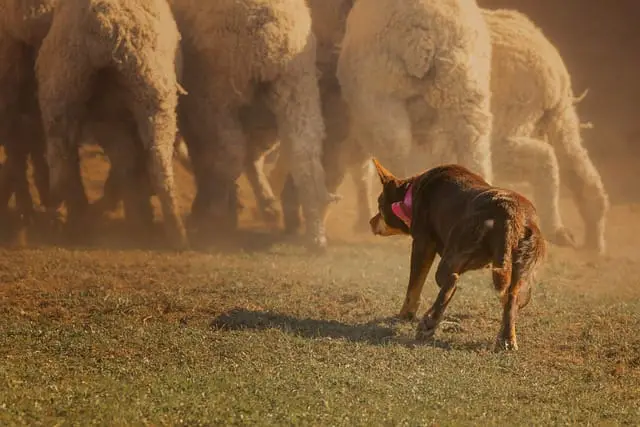Border Collies and Kelpies are two types of working dogs renowned for their exceptional herding abilities. While Collies possess a strong work ethic and impressive problem-solving skills, Kelpies are known for their endurance and adaptability in challenging environments.
Characteristics of Border Collie versus Kelpie
In the realm of working dogs, the Border Collie and the Australian Kelpie stand out for their remarkable abilities. The Border Collie, weighing in at around 30 to 45 pounds, possesses an extraordinary amount of energy and endurance. Developed to work tirelessly in the challenging terrains of the Scottish border country, these dogs would cover impressive distances of up to 50 miles daily. It’s hard to find a better candidate for the role of an exemplary working dog than the Border Collie.
On the other hand, the Australian Kelpie is a breed that thrives on work. Adapted to withstand the harsh climates and rugged environments of Australia, Kelpies have an unwavering dedication to their tasks. They are well-suited for herding livestock without human guidance due to their independent thinking. However, their penchant for independence can lead to some challenges if they are not given specific tasks to focus on.
Both breeds are exceptional in their own right, demonstrating their unparalleled work ethic and capabilities.
| Characteristic | Border Collie | Kelpie |
|---|---|---|
| Breed Group | Recognized by the American Kennel Club or AKC as a herding group | Recognized by the American Kennel Club or AKC as a herding group |
| Height | Anywhere between 18 inches to 22 inches | Anywhere between 15 inches to 20 inches |
| Weight | Roughly between 27 pounds to 45 pounds | Roughly between 25 pounds to 46 pounds |
| Coat length & texture | Coarse and varies in length, with several layers | Double coat that sports a weather-resistant outer layer |
| Coat color | 17 recognized colors similar to: • Patterns - white ticked, blue merle, red merle, sable merle, white and blue merle, white and red merle • Solid colors - blue, black, lilac, brindle, gold, red, sable • Bicolor - white and black, white and blue, white and red | Various colors, such as: • Black • Red • Chocolate • Smokey blue |
| Exercise needs | Regular and consistent exercise | Same with Border Collie |
| Intelligence | High | High |
| Barking | Has a tendency to bark often | Has a tendency to bark often |
| Life span | Up to 17 years | Up to 15 years |
| Hypoallergenic | No | No |
| Origin | Scotland | Australia |
History of Breeds
The ancestral roots of the Border Collie can be traced back to the early days of sheep herding in Britain. As humans began utilizing dogs for guarding and herding sheep, these dogs became invaluable assets to shepherds in the border region between Scotland and England.
Through selective breeding, the best working dogs were chosen to continue the lineage. Over time, different types of herding dogs emerged, each suited to the specific terrain and tasks of their respective regions.
The Australian Kelpie, on the other hand, has its origins in Australia. Black Collies were imported from Britain in the 1800s and were crossbred with various other breeds, including wild dingoes. These resulting dogs were robust and adaptable to Australia’s challenging climate, known for their tireless work ethic and independent thinking.
The name “Kelpie” was bestowed upon the breed when Jack Gleeson purchased one from George Robertson, a Scottish man. The breed underwent further crossbreeding over time, evolving into the modern Australian Kelpie we recognize today.
Comparing Appearance of Border Collies and Kelpie
The Border Collie is often likened to a lighter version of the Australian Shepherd, although it possesses distinctive features of its own.
Unlike the bobtail characteristic of the Aussie, Border Collies have a feathered tail that extends to their hocks. Their body is slightly longer than their height; their ears are erect but have tips that droop, lending them a lively appearance. The Border Collie’s coat can vary, with some individuals sporting a coarse coat that reaches around three inches in length, while others have a sleek coat that measures about one inch long.
The Australian Kelpie is known for its compact body and strong limbs. It has a slightly longer body than its height, with a broad chest and sturdy hindquarters, providing agility and energy.
The Kelpie’s head is long and narrow, while its medium-length tail sits low. The breed’s feet are short and compact, with well-arched toes. The Australian Kelpie boasts a double coat, consisting of a dense and short undercoat, providing insulation, and a hard, straight outer coat that repels weather elements.
Size
In terms of size, there are notable differences between the Border Collie and the Australian Kelpie. Male Border Collies typically stand at a height ranging from 19 to 22 inches and weigh between 35 to 45 pounds, while their female counterparts stand between 18 to 21 inches and weigh around 30 to 40 pounds.
On the other hand, Australian Kelpies are generally medium-sized dogs, weighing between 25 and 46 pounds. Their height at the shoulder typically falls within the range of 15 to 20 inches. It’s worth noting that individual Kelpies may vary in size, with some being smaller or larger than the average.
Overall, Border Collies tend to be slightly larger than Australian Kelpies in terms of both height and weight.
Coats & Colors
When it comes to coat colors, there are distinct differences between Border Collies and Kelpies. The American Kennel Club (AKC) acknowledges at least 17 standard colors for Border Collies. Additionally, the AKC acknowledges non-standard colors such as seal, slate, and white with different combinations.
Kelpies typically come in a limited range of colors. They commonly have tan markings on their face, legs, underbelly, and under the tail. Black and tan Kelpies may have a darker face with minimal tan markings, and some dogs may exhibit slight brindle markings on their legs.
Saddle-back Kelpies exhibit more prominent tan coloring on the face, legs, and underbelly, often with a complete face mask of tan. Plain colored Kelpies can be black, red, blue, or cream, with the absence of white being a characteristic feature of the breed. However, some white markings on the chest and toes are acceptable.
Personality & Temperament Difference of Border Collie and Kelpie

When comparing the Border Collie and the Australian Kelpie, both breeds share a common trait: a strong work ethic and high energy levels.
Border Collies are known for their attentiveness, liveliness, and alertness. They form deep bonds with their owners and families, but their herding instincts make them less suitable for households with very young children. Border Collies are devoted and will follow their owners anywhere, but they require ample exercise and mental stimulation to prevent mischief. They are determined, brave, and may nip those who don’t see eye-to-eye with them.
Similarly, Australian Kelpies are working dogs with an insatiable need for exercise and a job to do. They are highly energetic and will run tirelessly. Daily long walks and jogging are necessary to meet their exercise requirements.
Kelpies are compact, robust, and fiercely intelligent. They are loyal, obedient, and alert, making them dedicated companions. However, their boundless energy makes them unsuitable for suburban living. While they can get along with children when raised together, Kelpies have a tendency to herd other animals, including dogs and pets, whether they like it or not.
Dogs towards Family
When considering a suitable breed for your family, it is essential to find a match that aligns with both your lifestyle and the needs of the dog. If you lead an active lifestyle, have ample space like a large backyard or a farm, and can provide plenty of love and attention, a Border Collie might be the right choice.
These intelligent dogs require constant mental stimulation and thrive when engaged in active pursuits. Apartment living is not ideal for Border Collies as they have a strong desire to run, hunt, dig, and jump.
On the other hand, if you are seeking a medium-sized dog with an athletic build, a love for work, and a penchant for learning, the Australian Kelpie could be a suitable option. This breed is well-suited for families or individuals who are willing to integrate their dog into their lifestyle, as Kelpies thrive on exercise and do not enjoy being left out. Once trained, they give back more than they take, displaying unwavering devotion and loyalty to their family.
Kids
When it comes to compatibility with small children, there are contrasting characteristics between Border Collies and Kelpies. Border Collies, known for their strong work ethic, lively nature, and herding instincts, often struggle to get along with young children. However, this doesn’t mean that all Border Collies are incompatible with families. Successful integration into a family environment depends on factors such as:
- Proper training
- Socialization
- Addressing behavioral issues
- Meeting their exercise needs
On the other hand, Kelpies can be suitable companions for young children if they receive training and socialization.
While they have herding instincts and may try to herd children, their obedience and intelligence make them easier to train. With their quick learning abilities, they can readily pick up new tricks and commands. It is still advisable to provide supervision when Kelpies interact with young children to ensure everyone’s safety and well-being.
Other People
Both Border Collies and Australian Kelpies have distinct behavioral traits related to their interactions with strangers and territorial instincts. Border Collies are generally not aggressive by nature, and any aggression they display is often a result of inadequate training from their owners.
It’s important to be cautious when introducing Border Collies to new people, as they have a strong pack mentality and can be wary of individuals outside their family. If they perceive someone as a threat to their “pack,” they may display signs of aggression.
On the other hand, Australian Kelpies are not particularly trusting of strangers and exhibit a strong territorial nature. This makes them excellent watchdogs as they will bark at any potential signs of danger. This at the same time highlights the need for early socialization training for Kelpies. Additionally, it is beneficial to prevent neighboring pets from freely wandering onto their property to avoid triggering territorial behavior.
Dogs & Other Animals

Border Collies have a strong herding instinct, and their role as shepherd dogs is to keep the herd together. This innate trait makes them naturally protective of the herd and highly alert for any intruders. They may exhibit herding behavior by nipping at other dogs, and sometimes even family members. However, many Border Collie owners have observed that their Collies are not aggressive but rather affectionate and loving, displaying their gentle nature.
In contrast, Kelpies are quick to befriend other pets and dog breeds. With their herding background, it is not surprising for Kelpies to view smaller animals as part of their flock. These dogs are known for their friendly disposition, and once properly socialized, they tend to be gentle and non-aggressive throughout their lifespan. Their inherent friendliness and adaptability contribute to their amiable nature when interacting with other animals.
Behavior Issues
Border Collies are known for their exceptional intelligence, which allows them to learn quickly. However, this intelligence works both ways, as they can easily pick up good behaviors as well as undesirable ones. If not properly managed, behaviors such as excessive barking, digging, chewing, and restlessness due to boredom can lead to destructive behavior in Border Collies.
Similarly, Kelpies are natural-born athletes and require regular and vigorous exercise to stay happy and content. It is essential to provide them with solid exercise sessions at least once a day. When a Kelpie doesn’t receive sufficient exercise, they can become unhappy and prone to problematic behaviors similar to that of Border Collies.
Training & Exercise Comparison
Border Collies are renowned for their exceptional trainability, making them ideal for owners who wish to work on specific skills with their dogs. Whether you opt for professional training or conduct at-home exercises, Border Collies excel in both settings.
To maintain their focus during training sessions, it is helpful to use treats, toys, clickers, or other incentives that motivate them to overcome the more challenging aspects of learning. Additionally, varying training environments after an initial period of exploration can engage their adventurous nature and keep them stimulated.
Similarly, Australian Kelpies exhibit high intelligence and a strong desire to please their human companions, making them relatively easy to train. However, successful training requires a dedicated owner who consistently applies training methods and adheres to a structured schedule.
Since they are a little bit sensitive dogs, positive reinforcement and ample praise for good work should always be prioritized during training sessions, alongside gentle corrections when needed. Given their intelligence, Kelpies may even thrive in agility training and have the potential to participate in agility events, where they can showcase their competitive nature.
Taking Care & Maintenance of Kelpie versus Border Collie
When welcoming a new Border Collie or Kelpie puppy into your home, it’s essential to prioritize their care and ensure a positive experience. Both breeds require similar initial steps to set them up for a healthy start.
Scheduling a visit to the veterinarian for vaccinations and completing any necessary medical procedures is crucial. Additionally, puppy-proofing your home becomes a priority to protect your belongings, especially during teething stages.
Border Collie puppies may exhibit more chewing due to their high energy levels and tendency to become attached. Similarly, Kelpie puppies require the same precautions to safeguard furniture and other valuable items. These initial steps will help create a safe and suitable environment for the puppies to grow and thrive. By taking these measures, you can provide the necessary care and attention to ensure a smooth transition for both Border Collie and Kelpie puppies in their new homes.
Grooming of Kelpie versus Border Collie
All too often, you’d see Border Collies sporting two layers of coat that provides great insulation and also, weather protection. Their coat is resistant to matting and tangling, requiring only occasional brushing to remove dead hair and keep it in good condition.
On the other hand, Kelpies have a relatively low-maintenance coat, often referred to as a “wash and wear coat.” Despite being short-haired, Australian Kelpies tend to shed more than expected, so regular brushing is necessary to manage loose hair and minimize shedding. While active Kelpies usually wear down their nails naturally, it is still important to check them on a weekly basis to determine if they need trimming.
Shedding
Border Collies have a long-haired double coat, making them prone to shedding a significant amount of hair. Shedding is particularly noticeable during fall and spring, when they undergo excessive shedding. Many Border Collie owners find managing the shedding to be a constant task, as their hair tends to accumulate in corners, hide in inconspicuous areas, and even float through the air. It can feel like a never-ending battle, with Collie hair reappearing as if it has a mind of its own.
Kelpies have a short to medium-length double coat that sheds heavily. Regular brushing, usually once or twice a week, helps control shedding by removing loose hair and preventing it from accumulating.
Health of Kelpie versus Border Collie
Border Collies are wonderful dogs for individuals who can meet their exercise needs, and they can become your loyal companion when provided with ample opportunities for walks and physical activity. But just like many purebred dogs, Border Collies are susceptible to certain breed-related health problems and conditions that owners should be aware of.
On the other hand, the Kelpie is generally a healthy breed with a minimal number of hereditary issues. Bred to be resilient and robust, Kelpies typically have few health concerns throughout their lives.
Life Span
On average, Border Collies have a lifespan ranging from 10 to 17 years. However, it is more common for them to live to around 12 years, although there are rare cases of Border Collies reaching the age of 18 years. In comparison to other breeds of similar size, the median life expectancy for Border Collies falls within the range of 12 to 13 years.
Kelpies, on the other hand, typically have an average lifespan of 11 to 16 years. As with many medium-sized dogs, they may experience age-related complications as they reach middle age. However, Kelpies are generally considered to be a healthy breed overall, given their history as utility dogs.
Diet & Nutrition
Border Collies are active dogs with higher nutritional needs compared to less active breeds. They typically eat around 2 cups of dry dog food divided into two to three meals per day. A balanced diet of carbohydrates, proteins, and healthy fats is important for their overall health.
It’s important to note that the actual food intake and type may vary depending on factors such as size, life stage, and individual requirements. Seeking advice from a veterinarian is recommended to determine the appropriate portions and specific dietary needs for your Border Collie.
Similarly, Australian Kelpies, known for their energy and athleticism, require a substantial amount of high-quality dog food to support their active lifestyle. As puppies, they should be fed more frequently, about three to four times per day, gradually transitioning to two meals as they mature. Most adult Kelpies thrive on approximately two cups of food spread across multiple feedings.
Then again, it’s important to research appropriate portion sizes for medium-sized dogs and consult with a veterinarian to ensure your Kelpie receives the appropriate nutrition for their specific needs.
Health Issues Comparison
Common health concerns in Border Collies include
- Hip dysplasia – A condition where the hip joint doesn’t fit together properly, leading to arthritis. Screening through the BVA/Kennel Club Hip Dysplasia Scheme is recommended.
- Cobalamin Malabsorption (IGS) – An inherited blood disorder.
- Multi Drug Resistance (MDR-1) – Increased sensitivity to certain medications.
- Ceroid lipofuscinosis (CL) – A cellular disorder that causes premature death. Testing is available for this condition.
Meanwhile, Kelpies are generally a healthy breed, but they can be prone to certain ophthalmic conditions. These may include the following:
- Cerebellar Abiotrophy – A rare condition that involves the degeneration of the Purkinje cells in the central nervous system, affecting coordination and balance.
- Cranial Cruciate Ligament Rupture – This is a common cause of hind limb lameness in dogs, and Kelpies are prone to it.
- Hypothyroidism – Older Kelpies showing signs like lethargy, unexplained weight gain, hair loss, or skin disease should be screened for underactive thyroid.
- Microphthalmia – Some Kelpie puppies may be born with underdeveloped, blind eyes, characterized by small size and potential abnormalities such as hair growth within the eye sockets.
- Progressive Retinal Atrophy – Another ocular disorder common in the collie family, where the retina, responsible for vision, begins to degenerate.
Cost of Border Collie versus Kelpie
Border Collie puppies are typically priced between $300 and $1,000, with an average cost of $700. The initial expenses in the first year can amount to around $2,500, and the annual cost thereafter is approximately $1,395 (or $116 per month).
On the other hand, Kelpie puppies can range in price from $400 to $1,600, while adult dogs from reputable breeders may cost $2,450 or more. The cost of getting a Kelpie can vary depending on factors such as the breeder’s reputation and the dog’s lineage.
It’s important to note that these price ranges reflect the average costs associated with owning these breeds, and actual expenses may vary based on individual circumstances and specific needs of the dog.
Puppies
Truth is, both Australian Kelpie and Border Collie puppies are known for their high energy, charming personalities, and strong drive to work and play. When bringing a Border Collie puppy home, here are some important points to consider:
- Socialization – both breeds have excellent social skills and generally get along well with children and other animals, making them a great fit for families.
- Trainability – these dogs thrive on mental challenges and are very trainable. They respond positively to positive reinforcement training methods, making it easier to teach them new commands and tricks.
- Critical Development Period – Typically, such puppies are ready to join their new homes around nine weeks old. This is a crucial stage of rapid development and learning. Providing a nurturing and stimulating environment during this period greatly contributes to their overall well-being and growth.
Breeders & Centers
When looking to purchase a purebred Border Collie, you can expect to pay between $600 and $1,200. While this may still be a significant investment, it is considerably lower than the cost of a show-quality puppy.
For a Kelpie puppy with breeding rights or advertised as show quality with papers, the price can range from $900 to $1900 or even higher, especially for those from top breed lines and with a superior pedigree. On average, Australian Kelpies for sale have a price of around $400.
Conclusion: Which Is Better For Me, Kelpie or Border Collie?
Determining which breed is better is subjective and dependent on individual preferences and specific needs. Both breeds possess remarkable herding abilities, intelligence, and agility, making them highly capable working dogs.
The Border Collie’s exceptional intelligence and trainability make them a top choice for those who value a dog that can quickly grasp commands and excel in obedience training. Their problem-solving skills and strong work ethic contribute to their reputation as one of the smartest dog breeds.
Likewise with Kelpies, these dogs are renowned for their endurance, adaptability, and independence. Their agility and ability to work in challenging environments make them well-suited for demanding tasks. Kelpies thrive when given the freedom to make independent decisions while herding livestock.
Ultimately, the decision between a Kelpie or Border Collie depends on the specific requirements of the owner. Both breeds bring valuable qualities to the table and have proven themselves as exceptional working dogs. It’s important to assess individual needs and find the breed that aligns best with those requirements.



